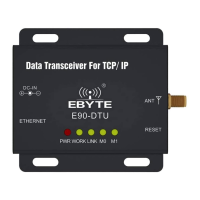
Do you have a question about the Ebyte E90-DTU and is the answer not in the manual?
| Model | E90-DTU |
|---|---|
| Category | Modem |
| Transmission Power | 30dBm |
| Operating Temperature | -40°C to +85°C |
| Baud Rate | 1200-115200 bps |
Lists required hardware for testing the E90-DTU.
Instructions for downloading debugging tools like NetAssist and XCOM.
Details on connecting antenna, RS485, and network cable.
Configuration of RF parameters for serial and gateway radios.
Step-by-step guide to configure the serial radio.
Steps to configure the gateway radio via network cable.
Overview of the device's general technical specifications.
Details on frequency bands, channel spacing, and number of channels.
Specifies transmit power levels for different models.
Lists available airspeeds and default parameters.
Defines subpackaging options and default parameters.
Outlines communication distances under various conditions.
Details TX and holding current consumption for different voltage inputs.
Provides physical dimensions and mechanical drawings of the device.
Explains the function of each pin on the device connectors.
Lists default LORA parameters like Module Address and Channel.
Detailed explanation of LoRa parameters and their settings.
Covers channel, module address, network ID, airspeed, and sub-packet length.
How to use 0xFFFF for broadcasting and listening.
Explains transmitting data to specific addresses and channels.
Describes different relay modes for network extension.
Details the use of communication keys for data encryption.
Explains the Listen Before Talk function for improved reliability.
Describes the Wake-on-Radio roles for power saving.
Functionality and use of Received Signal Strength Indication.
How to enable and read channel RSSI and ambient noise.
Configuration of Ethernet network parameters.
Explains DHCP and Static IP configuration methods.
Details on using random and static ports for communication.
Configuration of subnet mask and gateway.
How DNS is used for domain name resolution.
Overview of socket functions like TCP Server/Client, UDP Server/Client.
Configuration for TCP Server mode.
Configuration for TCP Client mode.
Configuration for UDP Server mode.
Configuration for UDP Client mode.
Configuration for HTTP Client mode.
Configuration for MQTT Client mode.
Configuration of heartbeat packets for client mode.
Details on sending registration packets in client mode.
Functionality and application of short connection in client mode.
How the device handles network disconnections and reconnections.
Configuration of timeout restart for stable operation.
Functionality for clearing serial port cache.
How to configure the device remotely.
Steps for performing remote firmware upgrades.
Guide to configuring the device via web interface.
Using configuration tools for parameter setup.
Configuring the device using AT commands.